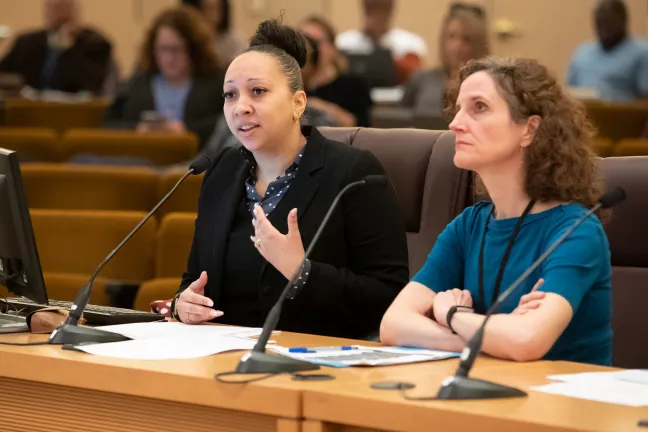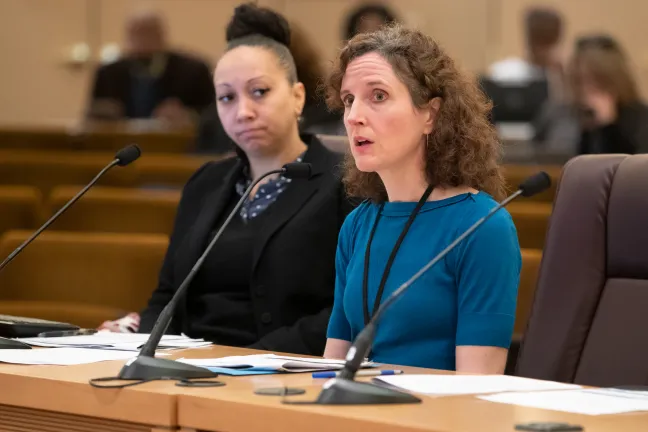Health Department leaders appeared Tuesday before the Board of County Commissioners, acting as the Board of Health, to lay out its priorities for public health improvements. The department has narrowed more than 40 concepts culled from community groups and advisory boards down to seven recommendations.
We should restrict the sale of flavored tobacco and nicotine products, which are most attractive to youth and cause dramatic health disparities between White and African American residents, Public Health Director Rachael Banks said Tuesday.
Other recommendations include:
-
Craft a policy on healthy food procurement
-
Create a plan to address poly-substance use
-
Expand suicide data collection and analysis
-
Adopt a county-wide violence prevention policy
-
Consider tighter regulations on alcohol
-
Adopt Vision Zero to make roads safer for bicyclists and pedestrians
The recommendations follow a year-long series of presentations to the Board on leading causes of death and health disparities among communities of color, both from health officials and the County’s Public Health Advisory Board.
Nearly 60 percent of Americans suffer from a chronic illness, most of which are preventable. In fact, health officials estimate a healthier diet, more exercise and smoking cessation could decrease the rate of stroke and diabetes by 80 percent and drop cancer rates by 40 percent.
Changes in lifestyle and community safety would disproportionately benefit communities of color, which suffer disproportionately from chronic illness, violence and injury. The estimated annual cost of health inequalities in Multnomah County is $442 million, including $332 million from premature mortality and $92 million in direct healthcare costs.
“Some policies we will bring forward may have an impact on business. And you will undoubtedly hear arguments about the business cost,” Banks told the Board. “But it’s important to remember the cost to society from not acting, and the cost of continuing to allow industry to profit from the death and sickness of vulnerable communities, including youth and communities of color.”
The recommendations come after years of public hearings, community listening sessions and advisory board meetings. Beginning in 2009, ACHIEVE and REACH gathered stakeholders to conduct community assessments and identify health priorities among people of color, particularly Black residents.
In partnership with the Oregon Health Equity Alliance, the Public Health Division created a Community Health Improvement Plan, identifying 150 strategies on health and safety. Earlier this year the county’s Public Health Advisory Board proposed the Board of Health focus on nine areas, beginning with nicotine, nutrition and safer streets.
Public health officials have since weighed in, researching best practices, talking with other jurisdictions, reviewing the literature, examining the evidence, exploring legal issues and considering the Country's capacity to act.
“We are focusing on what policies will turn the dial on leading causes of death,” Banks told the Board. “And where is there clear policy action and a role for the board.”
“The previous briefing set us up for an interesting conversation with policy next steps,” said Commissioner Jessica Vega Pederson. “We’re lucky to have so much input from experts and the community, as well as public health work in other jurisdictions.”
Poly-substance use
“When we think about substance use and misuse, it’s a very visible driver of health, and people tend to immediately think of opioids but we also have an alarming increase in stimulant deaths and in deaths attributed to stimulant and opioid abuse,” Deputy Health Officer Dr. Jennifer Vines told the Board Tuesday. “And we also have to look to alcohol...I hope to make the case we need to address all dangerous substances together.”
Vines outlined distinct waves of opioid misuse, beginning in 2009 with a rise in misuse of prescription drugs, leading to a resurgence in the use of heroin and finally to the introduction of synthetic opioids such as Fentanyl. Originally considered an epidemic of White rural America, overdose rates of synthetic opioids are now growing fastest among communities of color.
Vines asked the Board to consider expanding support for medically-assisted treatment, such as methadone and buprenorphine, which improve recovery rates for people addicted to opioids. And she asked the Board to consider establishing a taskforce that would set priorities and targets for implementation.
Alcohol
Vines also asked the Board to consider alcohol as a drug worthy of tighter regulation. Whereas 5 people per 100,000 die each year from illicit drugs in Oregon, 40 people per 100,000 die of alcohol. The short-term effects include overdose and poisoning as well as car accidents. Longer term effects include high blood pressure, liver damage and cancer.
In Multnomah County, half of young adults report they binge drink or use drugs every month and most say alcohol is easy to get, Vines said. The Health Department recommended that Commissioners consider tighter restrictions on alcohol sales and advertising.
“Place matters. What young people see and have access to matters,” she said.
Suicide
Each year in Multnomah County 124 people commit suicide. The rate of youth suicide has gone up 50 percent nationally since 2000, and access to guns increases the risk, Dr. Namisha Gokaldas, medical director for Mental Health and Addiction Services, told the Board. Yet one out of three homes with kids have guns.
For the County to craft an effective prevention strategy, it needs access to comprehensive and timely data. But it takes the state two years to provide counties with their suicide data.
“Is that normal?” Commissioner Sharon Meieran asked.
“It’s normal for Oregon,” Gokaldas said. “One area we want to do more of is get data in a timely manner, expand monitoring and analysis. We don’t have a systematic approach.”
Gokaldas asked the Board to consider supporting a policy for more comprehensive data gathering and analysis to form a better approach to prevention. Some of the best data would be attempted suicides, rather than completed attempts, she said. The attempts suggest someone is at risk, and allows time to intervene.
“Yes we can do deeper dives on completed suicides, but how do we intervene?” she asked. “Washington County has done a fabulous amount of work in this.”
Violence, safe streets and nutrition
Other recommendations included establishing a violence prevention policy based on intervention and prevention measures such as mentors, job readiness programs and family support. Violence prevention starts by preventing adverse life experiences, said Frank Franklin, Ph.D., director of Community Epidemiology Services at Multnomah County’s Public Health Division.
Public Health Director Banks also laid out recommendations for adopting a Vision Zero policy to make streets safer for pedestrians and cyclists. Each year in Multnomah County, an average of 41 people die in traffic accidents.
“But the burden goes beyond that crash,” Banks said. For every one person killed, 8 are hospitalized, and 99 are treated and released. African American residents are more than twice as likely as White residents to be the victims.
“So the impact is much broader,” she said.
Banks also recommended policies to improve access to healthy food in a county where fewer than one-in-four people eat at least five servings a day of fruits and vegetables, where more than one-in-10 high schoolers are obese and where one-in-five children are food insecure.
Banks urged the Board to consider creating county-wide nutritional guidelines for county-purchased food and drinks, and any food served at county facilities such as jails.
Chair Deborah Kafoury thanked the panelists for the recommendations.
“Each of us on this Board knows that because we will be facing tough budgets in the years to come, we will need to move ahead wisely and prioritize those policy decisions that will make the most difference,” Chair Deborah Kafoury said.




